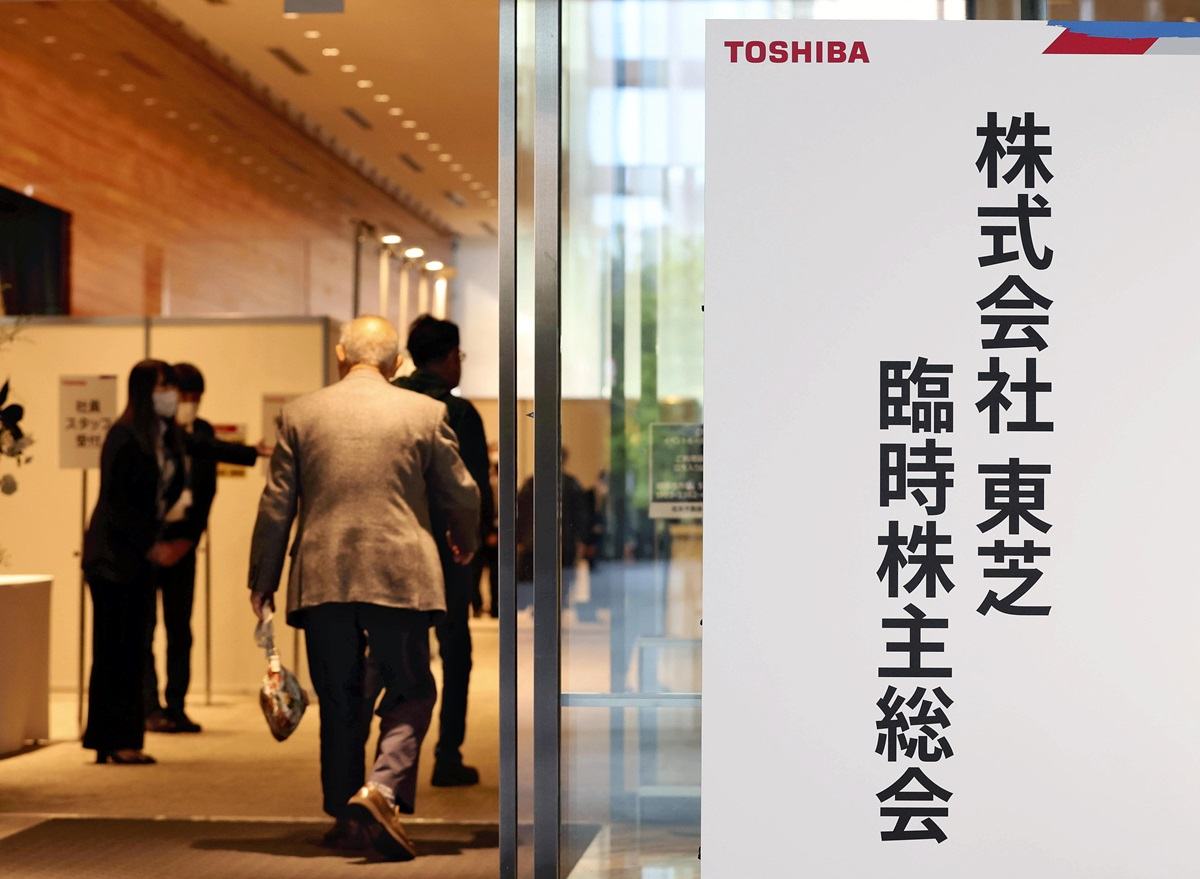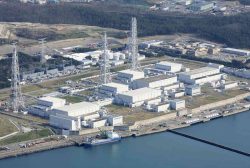Toshiba Aims to Rebuild in Private to Evoke Past Glory, Wipe Away Ghosts of Recent Turmoil

Stockholders are among those arriving at Toshiba Corp.’s extraordinary shareholders meeting in Shinjuku Ward, Tokyo, on Wednesday.
21:00 JST, November 23, 2023
With Toshiba Corp. formally deciding to take itself private, expectations are that the company will be putting to rest the management turmoil that has existed since inappropriate accounting was exposed in 2015.
As one of Japan’s name companies, Toshiba was hailed in the past for its technological prowess, etched in the history of the nation’s home appliances.
“Having a stable shareholder will allow Toshiba’s innovative technologies to shine again around the world,” Toshiba President Taro Shimada said during an extraordinary shareholders meeting in Tokyo on Wednesday, when the decision was made to delist the company on Dec. 20 after 74 years.
Many shareholders voiced harsh opinions.
“Since 2015, Toshiba has lost credibility, lost business, lost personnel,” said one person at the meeting.
Among those showing understanding of the delisting, one person said, “We must avoid having Toshiba liquidated and its sensitive technologies dispersed.”
The inappropriate accounting issue came to light in April 2015. Successive Toshiba presidents set high performance goals and exerted intense pressure on employees to achieve them. To make it look like Toshiba was performing well, losses were repeatedly not recorded at appropriate times. The three most recent presidents blamed for the trouble resigned en masse in July 2015.
The hope then was that Toshiba would be on the path to rebuilding itself into what it once was.
Then came the collapse of U.S. nuclear power firm Westinghouse Electric Co., which Toshiba had bought years earlier. Toshiba fell into insolvency of ¥550 billion in liabilities in its business year ended March 2017.
“It occurred when we were about to turn around our business for the better,” said a former Toshiba executive. “It caught us by complete surprise.”
Toshiba had bought Westinghouse for more than ¥600 billion in 2006, expecting a boom in construction of new nuclear power plants.
The nuclear accident at the Fukushima No. 1 nuclear power plant in 2011, however, spoiled Toshiba’s plans. Security standards for nuclear power plants became more rigorous worldwide, leading to delays in their construction and bringing significant losses to Toshiba.
The company was removed from the then First Section of the Tokyo Stock Exchange in August 2017 and placed in the lower-tier Second Section.
Toshiba’s rebuilding plans were thrown off the rails.
‘Pride’
At the time, Toshiba insisted on remaining a listed company. Firms that are insolvent for two consecutive business years are automatically delisted. To avoid the situation, Toshiba accepted ¥600 billion in funds from activist shareholders, including those from overseas.
After the capital increase, however, conflicts occurred between Toshiba’s top executives, who sought mid- to long-term growth, and the activist shareholders including foreign funds, which wanted short-term returns on their investment.
One former outside director of Toshiba said the firm’s leadership at the time made the wrong decision.
“Dubbed a ‘group of aristocrats,’ their pride was sky-high that they delayed the rebuilding efforts just to remain a listed company,” this person said. “The company should have been delisted in 2017, then the rebuilding would have been quicker.”
Toshiba was once a rival to Hitachi, Ltd., which declared huge losses after the collapse of U.S. investment bank Lehman Brothers in 2008. Hitachi, however, made a sharp recovery by thoroughly focusing on choosing the business areas it should concentrate on. Toshiba chose not to take fundamental measures and continued to languish.
“There wasn’t anyone who had conviction and could see the big picture,” said another former outside director of Toshiba.
Toshiba needed the activist shareholders to stay listed as it had always wanted, but now that it wants to get rid of them, ironically, it had to choose the path of delisting.
‘Precipice’
After going private, Toshiba aims to rebuild under a domestic alliance of companies such as Japan Industrial Partners, Inc.
The company has set a goal for a substantial increase from the consolidated sales of ¥3.3 trillion and the operating profit of ¥110 billion in the business year ended March 2023. In the business year ended March 2015, Toshiba had sales of ¥6.6 trillion.
In these last eight years, the turbulent circumstances meant that Toshiba needed to secure funding by selling many businesses, such as its semiconductor, medical equipment and electric appliance sectors.
Toshiba will also put its energy into infrastructure businesses, such as electric power and railways, as well as data gathering and analysis.
Shimada, the current president, came to Toshiba in 2018 after working at Siemens K.K., the Japanese arm of the German electronics giant. He is knowledgeable in the digitization of manufacturing businesses, so strengthening data-related sectors will be imminent under his auspices.
The company will still need to find a way to succeed amid the myriad rivals in the field, namely the tech giants of the United States.
Waseda University Prof. Atsushi Osanai, who is well-versed in the electronics industry, had this to say about Toshiba’s new path after going private.
“Toshiba’s strength is that the company has digital technologies as well as the hardware technologies to implement them,” Osanai said. “Now that the company is on the precipice, it is necessary to persevere in implementing the policies set forth by top management.”
"Business" POPULAR ARTICLE
-

Tokyo Economic Security Forum to Hold Inaugural Meeting Amid Tense Global Environment
-

Keidanren Chairman Yoshinobu Tsutsui Visits Kashiwazaki-Kariwa Nuclear Power Plant; Inspects New Emergency Safety System
-

Imports of Rare Earths from China Facing Delays, May Be Caused by Deterioration of Japan-China Relations
-

University of Tokyo Professor Discusses Japanese Economic Security in Interview Ahead of Forum
-

Japan Pulls out of Vietnam Nuclear Project, Complicating Hanoi’s Power Plans
JN ACCESS RANKING
-

Tokyo Economic Security Forum to Hold Inaugural Meeting Amid Tense Global Environment
-

Keidanren Chairman Yoshinobu Tsutsui Visits Kashiwazaki-Kariwa Nuclear Power Plant; Inspects New Emergency Safety System
-

Imports of Rare Earths from China Facing Delays, May Be Caused by Deterioration of Japan-China Relations
-

University of Tokyo Professor Discusses Japanese Economic Security in Interview Ahead of Forum
-

Japan Pulls out of Vietnam Nuclear Project, Complicating Hanoi’s Power Plans




























